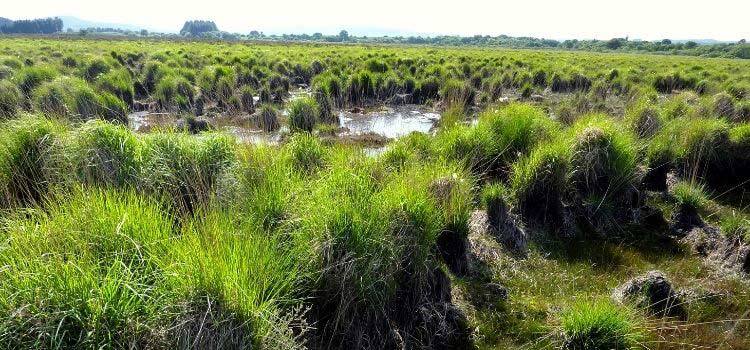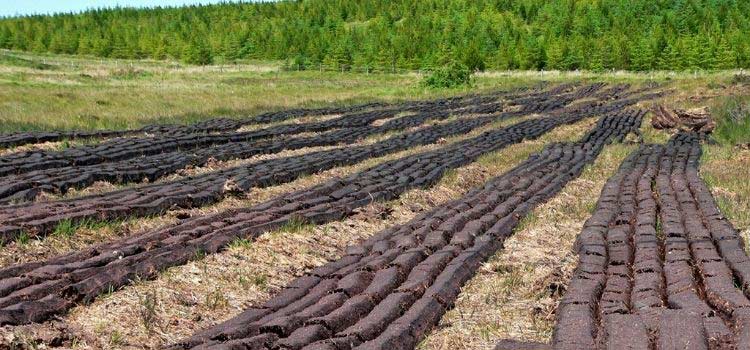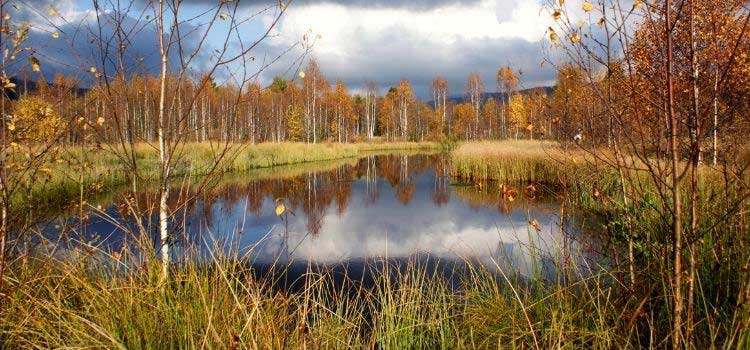If you buy potting soil commercially, there is a very high probability that it contains peat. Indeed, it is almost systematically integrated into substrates for its physical qualities, in terms of lightness and water retention. However, the widespread use of peat has a significant environmental impact! This involves the destruction of wetlands that are ecologically important. Fortunately, there are solutions to preserve them. Let’s take a look at the advantages of peat in the garden, the consequences of its use, and discover how to preserve this resource!
1- What is peat and where does it come from?
Peat is a fossil organic material that results from a slow accumulation of organic matter in an acidic, water-saturated environment that is very low in oxygen. These conditions prevent microorganisms, bacteria, and fungi from decomposing the organic matter, which therefore accumulates gradually. These particular environments are known as peat bogs.
As the organic matter is not decomposed, these environments are very low in mineral elements, leading to the development of specific fauna and flora. Many carnivorous plants (such as sundews and Sarracenia) can be found in peat bogs: they capture insects to supplement their nutritional needs, as they cannot draw nutrients from the soil, which is too poor.
Peat can take between 1,000 and 7,000 years to form. Therefore, it is not renewable on a human timescale. Ultimately, after a million years, the organic matter constituting peat bogs transforms into coal.

There are different types of peat:
- Blonde peat: it comes from sphagnum moss. It is relatively young (between 3,000 and 4,000 years) and fibrous. This is the layer that is found closest to the surface in a peat bog. It has an excellent water retention capacity, as sphagnum absorbs water. It is the most commonly used peat in horticulture and gardening.
- Brown peat: it originates from woody plants (trees, bushes), sedges, reeds, and Ericaceae. It is older (about 5,000 years) and found deeper down. It can also be used in the garden, although its use is less frequent.
- There is also black peat, which is older (up to 12,000 years). It is mainly used for wastewater treatment.
Thus, the darker the peat, the older it is.
2 - The advantages of peat in the garden
Peat has many qualities that plants need, to the point that it is difficult to replace. It is no coincidence that its presence has become almost systematic in marketed potting soils.
Peat acts like a sponge: it stores water and mineral elements, preventing the substrate from drying out too quickly. It has an excellent water retention capacity. Peat is therefore ideal for potted plants: as it stores water, watering can be spaced out or occasionally forgotten without the plants suffering too much. It is a particularly light and airy material that does not compact: thus, it is ideal for good root development. Indeed, in pots, the substrate can quickly tend to compact and suffocate the roots. Peat also has the advantage of providing a stable substrate that does not decompose or deteriorate.
Peat is particularly useful for substrates intended for repotting indoor plants, flowering plants for the terrace, etc. It is also widely used for growing carnivorous plants, as it perfectly matches their natural environment.
Dehydrated peat pellets are also available, used particularly for sowing. They swell as soon as they are rehydrated. Peat is also used to make biodegradable compressed peat pots.
3 - What problems are posed by the use of peat?
As peat bogs are very particular environments (acidic, saturated with moisture, low in oxygen), over time, a specific flora and fauna develop that cannot be found elsewhere. Many rare and protected species live in peat bogs and cannot adapt to other environments. These are mainly plants of wet and acidic soils. Sphagnum is very characteristic of peat bogs: it is a type of moss that absorbs water and tends to acidify the environment. It is the basis for the formation of peat bogs. In these wetlands, one can also find carnivorous plants, as well as Ericaceae, Cyperaceae, cotton grass, and reeds... Similarly, some plants (royal fern, molinia, Carex...) form tussocks: these plants grow on their old roots and dead leaves because these cannot decompose, thus forming clumps or micro-mounds.

In addition to their great biological diversity, peat bogs act as a true sponge... not only at the substrate or potting soil level, but the same happens on a regional scale. They limit the risk of flooding and also release water during dry periods. They play a crucial role in the hydrological balance of certain regions. Moreover, peat bogs store a significant amount of carbon (as they can be composed of 50% carbon), thus limiting global warming. They help regulate the climate on a global scale and also create cool microclimates. Peat bogs also have the advantage of filtering water: they purify it by removing various pollutants, thus acting as a natural purification station! The waters they release into the environment are therefore particularly pure.
Peat forms at a very slow rate of about 1 mm per year, or even less, which means it is not renewable on a human timescale. It takes thousands of years to form!
The importance of peat bogs is not "only" environmental; they also have a genuine historical interest. As peat forms very slowly and the material does not decompose, objects as well as plant or animal remains remain intact, allowing for a faithful tracing of a region's history. They are true archaeological archives! Human mummies in perfect condition, dating back thousands of years, have been found in peat bogs. Similarly, pollen grains are very well preserved in peat, allowing for the reconstruction of the vegetation and climate of a region thousands of years ago.

The exploitation of peat bogs is a true ecological disaster. They are drained and dried to extract peat. Generally, the soil then becomes dry and poor, and the typical plants of peat bogs will not be able to return.
The destruction of peat bogs is unfortunately not new. In the past, they were often considered useless and unexploitable environments, so they were drained to create agricultural land.
The figures are staggering: in France, half of the peat bogs have disappeared over the last 50 years. Fortunately, those that remain are now protected, which does not prevent the exploitation of peat bogs in other countries. Nearly 70% of the peat used in France for horticulture comes from the Baltic States (Estonia, Latvia, Lithuania) or Ireland. Thus, the problem remains the same, as it is the peat bogs of these countries that are now threatened.

4 - Our tips and best practices to preserve this resource
Fortunately, there are alternatives to peat, with some materials having the advantage of being light and airy while retaining water and nutrients: these include coconut fibres, composted bark, wood fibres, and pine bark... Similarly, vermiculite is ideal for lightening the substrate. There are also patented substitutes that are real alternatives, such as Turbofibre® (conifer bark fibre, replacing blonde peat) or Hortifibre® (wood fibre).
If you are growing acidophilous plants, we recommend using composted pine needles or bark.
Leaf compost is also a good alternative to peat, which has the added advantage of being rich in mineral elements and microorganisms. You can make your own potting soil by mixing well-decomposed compost, garden soil, and coarse sand.
Today, there are more and more peat-free potting soils on the market, often composed of coconut fibres, bark, wood fibres... They are quite effective. For example, check out Père François Or Brun universal potting soil. or Ecolabel universal potting soil.
However, be wary of the "Organic" certification, which does not guarantee the absence of peat; on the contrary! Indeed, peat, by definition, is a natural and organic material, so it can very well be included in the composition of "organic" potting soils. Read labels carefully and analyse the composition before purchasing. Prefer Ecolabel certification, which certifies peat-free potting soil.
If you continue to use potting soils with peat, do so sparingly. Limit your use by reserving it for indoor plants and the most sensitive plants, grown in small pots with low water and mineral reserves, or those that cannot tolerate drought. For less fragile outdoor plants in large containers, you can create your own substrate composed of compost, garden soil, and coarse sand.
































Comments